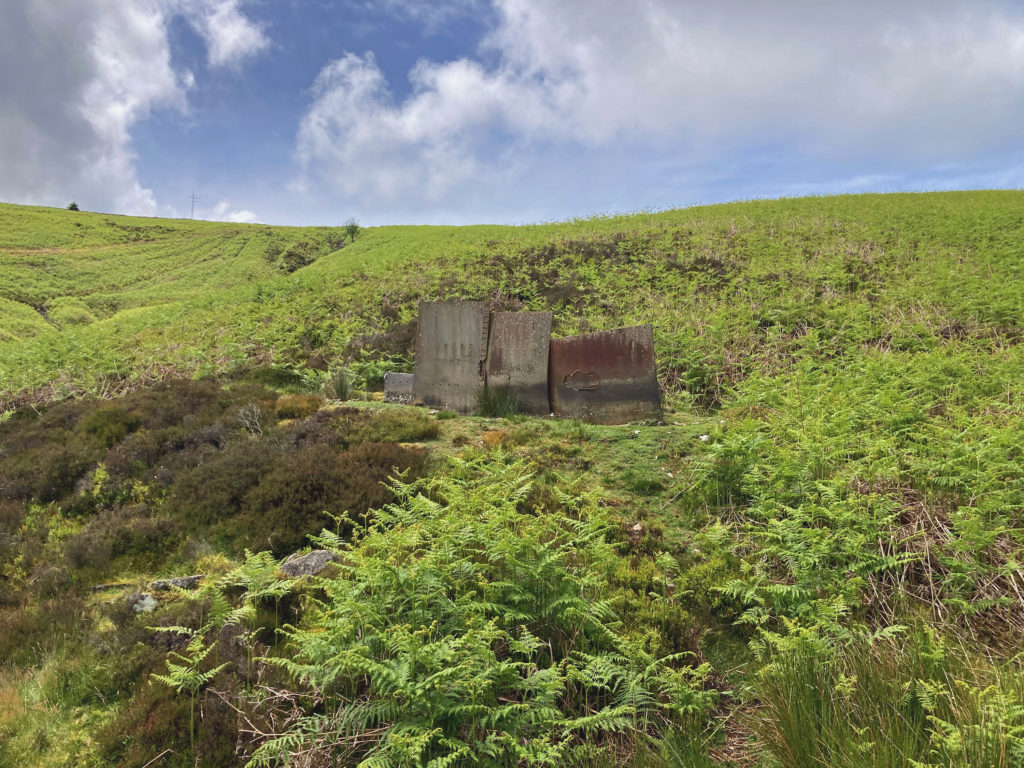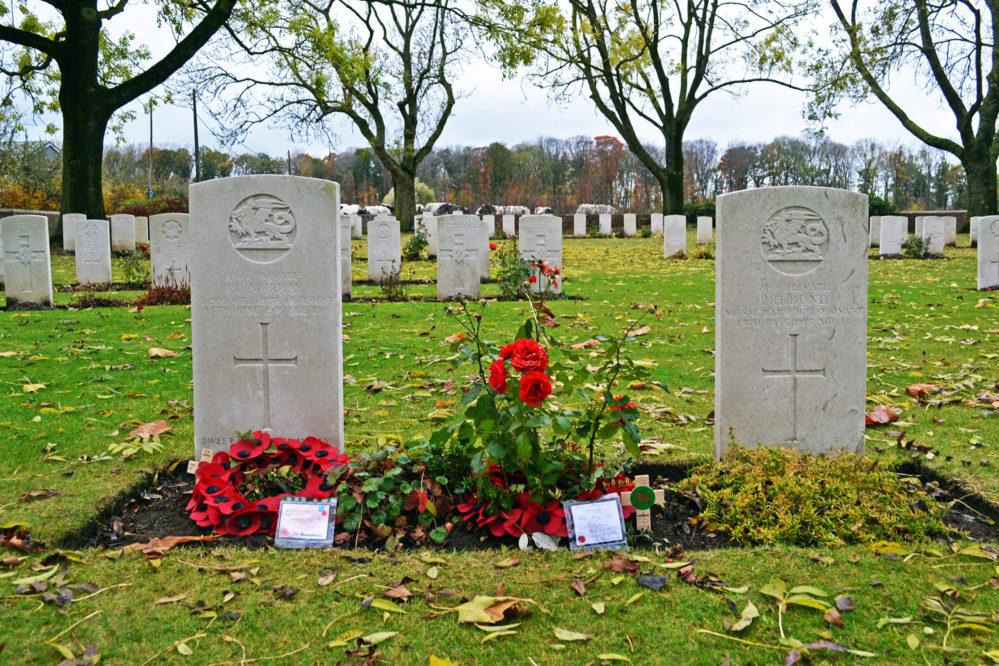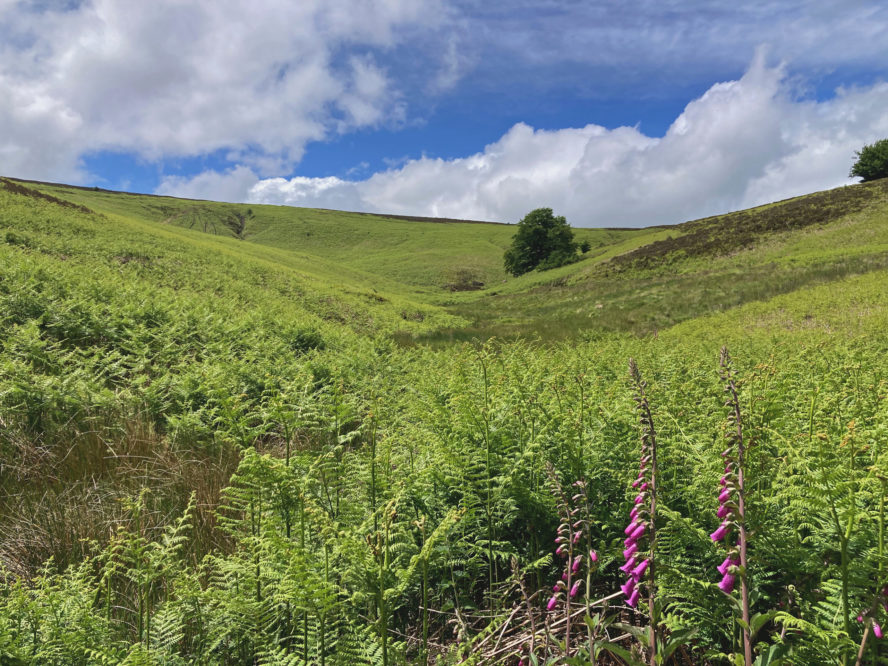Y Filltir Sgwâr/The Square Mile: Bobby’s Helmet

In a year long series Tom Maloney, from Abersychan, shows how you can love a place so well it becomes a part of you.
A little out of the way and certainly a little strange to see for the first time is a place that is simply called ‘Targets’ on the OS Map for the area.
It is just over the hill from the old farm ruins at Graig Ddu featured in one of my earlier articles and I seem to recall that I first came across this intriguing valley when I had been following the course of the Blaengaefog Brook.
I think most people who know of it in the Abersychan area would call it ‘The Targets’ but if you hail from the other side of the mountain at Abertillery it may be more familiar as ‘Bobby’s Helmet’.
Alan Coles, a fantastic photographer who posts on Twitter @thevalleytogger recalls: “As a lad I lived in Abertillery and we used to go to the spot we called Bobby’s Helmet, basically I think because it reminded us of the old fashioned helmet we used to see on Dixon of Dock Green.”
Over the past month I have visited the valley several times as I have begun to wonder if there could be a connection with my great uncle Joseph Murray, who sadly died on June 15th1915, one of the many who fell during World War 1.

‘The Targets’ are at the end of the valley and have been set into or on top of a raised platform.
Seen up close they are made up of four sheets of very thick plate steel, lined with rivet holes that look they could have been originally intended for shipbuilding.

It is clear that some degree of effort was involved in setting them up at this location. They have a ‘military’ purpose about their look with one of the sheets being inscribed with squares and a circle that shows evidence of very forceful impacts.
The sharp ringing, pinging sound of bullets hitting the sheet metal plates must have been deafening in this enclosed area and the danger from a ricochet must have been considerable.
Nearby, and to one side out of the line of fire when looking down the valley is a rusty domed structure, that has the look of a spotter’s hut, though I would cast some doubt as to its safety for this dangerous job.
And what of the history of this site?
Rifle range
Coflein, the online catalogue of archaeology, buildings, industrial and maritime heritage in Wales cites the evidence of OS maps to show that the site was in use until at least 1920 as a rifle range with an 800 yard range. While it does not specifically state that the range had a military purpose, this would seem to be likely.
Joe Murray served in the local Territorial Army unit, the 1/2nd Battalion of The Monmouthshire Regiment and I think it is more than probable that along with other members of his battalion that he undertook rifle practice here before the outbreak of the First World War.
The photograph that I have of him in his army uniform shows a very happy young man bursting with pride and I can quite imagine that rifle practice was one of the things that all of his unit enjoyed before the reality of war sunk in.

And what of Joe’s story?
The earliest memory relating to Joe goes back in time to when I was very young. I recall being crouched between the legs of my father and listening to the talk of adults as they smoked.
The conversation around the tragedy that befell Joe has stayed with me over the years. Joe’s position in the line was revealed to a sniper as he lit a cigarette and his life was taken in a moment.
I have visited his grave in Belgium several times, the last occasion being to commemorate 100th anniversary of the ending of the war on the 11th November 2018 with my sister.

Research
At different times I have tried to find out more about his life. My first port of call was to delve into the Free Press Archive held at Gwent Archives. Gwent Archives has a wealth of information that can assist with family research.
An obituary for Joseph Murray was published on the 2nd July 1915 and includes the following extract from a letter of condolence sent by his commanding officer –
‘Please accept my deepest sympathy on the loss of your gallant son, who fell on the evening of the 15th June. It will be some consolation for you to know that death was instantaneous – a bullet passed through his head.’ (Free Press of Monmouthshire, 2nd July 1915, p 13)
While a sniper is not mentioned, it is strongly implied, particularly by the use of the word instantaneous. This would suggest that the shot had been aimed. Given that the officer writes that it happened during the evening, the story of an unguarded light giving away his position is perhaps not surprising.
Valuable
I next turned to the war diaries for the Monmouthshire Regiment held at the Regimental Museum of The Royal Welsh, Brecon, another valuable repository of historical information. The Battalions and companies of the Regiment had by this time been amalgamated due to the severe losses that had been sustained in the battles for Ypres.
Diary entries are to the point. The entry for the day Joseph Murray died is as follows –
‘15th June – VIERSTRAAT – Some shell fire in M3 & N1. 1 killed 5 wounded – weather very hot and fine.’ WAR DIARY for June 1915, 1st, 2nd & 3rd Battalions Amalgamated, The Monmouthshire Regiment (Ref. Number WO95 – 2274-4).
The only death recorded in the War Diary is associated with shellfire, so this is more likely to be how Joe was killed in action.
I have often thought about the discrepancy between the two and my thoughts go out to the officers who had to write letters of condolence to families. The intention of the letter was probably meant as a kindness for the family.

Tranquil
The valley of ‘Bobby’s Helmet’ is world away from war today, a tranquil place where you are more likely to hear the distinctive sound of Stonechat birds rather than the crack of rifles being fired.
It would seem to me that this is a special site that deserves some archaeology and some protection for the future.
Whether or not I am walking in my great uncle’s footsteps, it is difficult to be absolutely certain, but when I visit again in the future I will think of him. I will also think of Charles Henry Bond, also of the 1/2nd Battalion The Monmouthshire Regiment, who lies buried beside him in Ypres.
As I was researching Joe I read a letter that Charles had sent to home just before his death in the line, again published in the Free Press of Monmouthshire. Where lies the truth in war? This is a letter that I think says it all.
‘Glad to say I am in the best of health – still kicking; and if I get through this, mother, I am the luckiest boy on Earth. I have got through so far, and it is luck that I have not been shot.
‘We have gone through bullets like hailstones coming down on us, and may God spare me to come home once more. We are having it a bit rough with the gas. It is not war; it is murder. I hope you enjoyed your Whitsun – I am having mine in the trenches.
‘May God bless you and keep you well until we meet again – I don’t think it will be in this world, it will be in the next one. I have given up hope of coming home, although I may have the luck to do so.’
Read the earlier installments of Y Filltir Sgwâr/The Square Mile by Tom Maloney
Support our Nation today
For the price of a cup of coffee a month you can help us create an independent, not-for-profit, national news service for the people of Wales, by the people of Wales.




